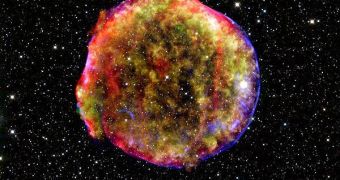The stellar explosions that form type 1a supernovas are among the most important events that can happen in space, scientifically speaking. Their steadfast level of luminosity, which is perceived as never-changing, has thus far helped astronomers create maps of distances between the various objects in our surroundings, and has also helped them determine the speed at which the Universe is extended, up to a certain level. But a new study, published in this week's issue of the respected scientific journal Nature, hints that variability exists in supernova light, and that it needs to be accounted for, if all other measurements are to be considered correct.
“As we begin the next generation of cosmology experiments, we will want to use type 1a supernovae as very sensitive measures of distance. We know they are not all the same brightness, and we have ways of correcting for that, but we need to know if there are systematic differences that would bias the distance measurements. So this study explored what causes those differences in brightness,” explains University of California in Santa Cruz (UCSC) Hubble postdoctoral fellow Daniel Kasen, also the lead author of the new paper.
Accurately assessing the traits of supernova-emitted light will in future experiments also play a fundamental role in determining the characteristics inherent to dark matter. The elusive substance has been discovered through the use of supernova light, but finding out whether any of its traits vary in time or not is entirely dependent on highly precise measurements of the stellar explosions. If these readings are compromised, then none of the ensuing studies can be considered reliable.
Computer simulations conducted by researchers have revealed that the main reason why supernova light is not uniform is the fact that the explosion is not symmetrical, in that it does not start dead square in the middle of the star. “Since ignition does not occur in the dead center, and since detonation occurs first at some point near the surface of the exploding white dwarf, the resulting explosions are not spherically symmetric. This could only be studied properly using multi-dimensional calculations,” says UCSC professor of astronomy and astrophysics Stan Woosley, a co-author of the new study.
“The reason these supernovae are not all the same brightness is closely tied to this breaking of spherical symmetry,” concludes Kasen. This study was supported by the Department of Energy's Scientific Discovery through Advanced Computing (SciDAC) program. Computer time was provided by NERSC and ORNL through an award from the Department of Eneregy's Innovative and Novel Computational Impact on Theory and Experiment (INCITE) program.

 14 DAY TRIAL //
14 DAY TRIAL //